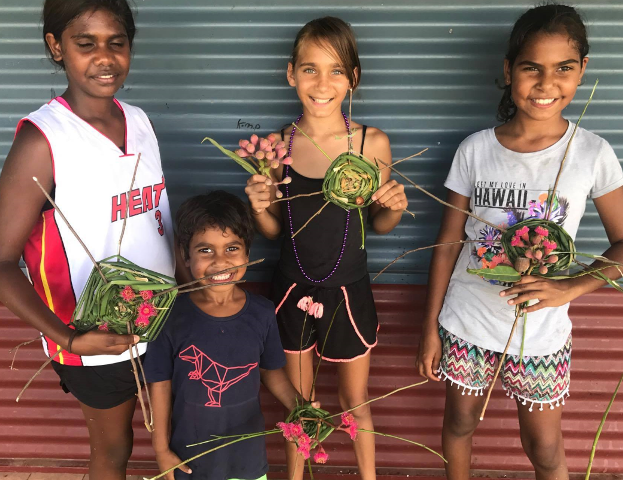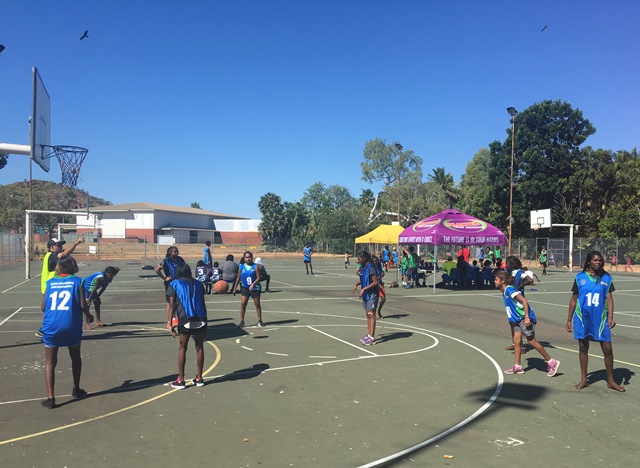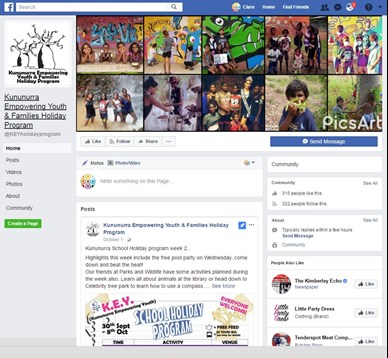Kununurra Empowering Youth
In October 2016, the East Kimberley District Leadership Group decided to focus on children and young people in Kununurra, to ultimately reduce the significant youth incarceration rates during school holiday periods (particularly during December/January holidays), and to increase community and child safety during this same period.
Engaging with at-risk children and young people

Overview
The group adopted a collaborative approach and developed school holiday programs that aimed to engage children and young people during a time of the year when young people historically become vulnerable to anti-social behaviour and on occasions, incarceration.
Part of the focus was to encourage the participation of family members in the activities and to ensure appropriate supports were in place for the ‘at risk’ youth who attended the program. In addition, the collaborative approach sought to identify and implement mutually reinforcing activities that enacted the East Kimberley Empowered Communities five social norms.
The Kununurra Empowering Youth (KEY) working party consisted of Government agencies (all levels), not for profit organisations, local Aboriginal community controlled organisations, and volunteers. The methodology was based on Collective Impact design principles with the underlying premise that no organisation can create large-scale lasting social change alone. The approach ensures there is partnership and leadership in the design, planning and implementation of community specific solutions and outcomes.
The common agenda of KEY includes:
- improving the content and coordination of programs available for young people in Kununurra, during school holiday periods
- ensuring programs encouraged children and young people to make good choices
- promoting positive family time and strengthen relationships between young people, their families and the wider community
- ensuring the views and ideas of local young people are included in the planning and implementation
- reducing anti-social behaviour, juvenile offences and periods of incarceration.
To develop the program and calendar of events, advice was sought from the young people, local Aboriginal leadership, and service providers. Feedback was specifically obtained from the identified ‘youth at risk’, mostly aged between 10 to 15 years and who are generally disengaged from education and other mainstream activities.
Activities offered as part of the program included basketball, football, pool parties, weaving, discos, movie and skate nights, indoor soccer, street art, bush tucker trips back to country visits, make up evenings and performing arts events.
The calendar of events document used to promote the activities incorporates artwork by a young person from the local community, who won a competition ran by the working group to design the logo for the KEY initiative.
A social media page for the program is available.
Development of focus
The success of KEY has been underpinned by a collective impact response to an issue that affects the whole of community. It quickly became a vehicle for the whole community to work together as one, for positive results.
Part of the focus needed to be on those young people with complex needs and who were already vulnerable to being further engaged in the criminal justice system. Often the young people had prior, as well as current, contact with police, justice and child protection systems, were disengaged from school and had already spent time in Banksia Hill Detention Centre. Young people in this high risk category were identified by government and non-government agencies and a deliberate effort was made to consult young people about how their time could be better spent during the holiday periods. It should be noted that for many, there was no difference between holiday and school term periods, as they were either partly engaged in the education system, or not at all.
The conversations between service workers and the young people aimed to ensure the young people were very much a part of the discussions around the construction of the school holiday activities and focus; and attempted to create a sense of ownership and responsibility for the outcomes, particularly for themselves, but also for their peers.
KEY was promoted through other mediums and agencies for their information, to ensure people were aware from a participatory point of view, and also to make a supporting contribution. KEY was re-enforced at a youth sector planning session, in which all organisations in Kununurra in the youth space were invited to attend. At the planning session, there were opportunities to learn about the aims and objectives of KEY, to gain ideas and resource information from the broader sector and from Aboriginal Elders, and to develop conversations about future focus areas. The involvement of disengaged young people in the education system was one of the areas raised, and where there was an appetite for a collective focus on this issue, including the development of an education forum.
Engaging with at risk children and young people
KEY used the following process to engage with hard-to-reach children and young people.
- Speaking with young people in their familiar environments. i.e. school or hang out places – pre the school holiday period.
- Ensuring those agency staff who have existing relationships and regular contact with young people were aware of the engagement required, and could undertake these conversations i.e. police, youth justice, Save the Children, Waringarri’s One Family At A Time and back to Country programs.
- Holding community events that catered for the interests of ‘at risk’ youth, and where engagement with young people by agency staff could occur in an informal setting.
- Ensuring local Aboriginal community controlled organisations and not for profit organisations were engaged in the activities, as well as the planning and delivery work.
WHY | HOW | WHAT NEXT
The themes of the conversations with young people included the why (the need), the how (what works/where best/interest based/incentives) and the what next (future possibilities/learnings). Conversations focused on activities that would engage families with their children, ideas of sporting related activities to release energy/team dynamics/mutual enjoyment for whole of family, activities that could cater for children of different ages and opportunities for older children to look after the younger ones, activities that could happen on country and activities where kids could learn and then replicate in their own homes. As a result, there was a marked increase in the number of parents and older siblings attending events with the younger children, to such a level that service providers running the events commented, saying they had never seen this level of engagement from families before.
Feedback from young people was obtained after the school holiday period, which will contribute to the next phase – many young people reported attending more than one event. They were positive about family/community involvement and felt more confident about talking to agency staff at these events.
Lessons learnt
A number of learnings were taken from the project:
- A number of young people were identified as having leadership traits, potential and willingness to be strong role models for their peers, observed through behaviour exhibited during events, such as helping the organisers to assist in setting the events up, cooking food for the events, and speaking up.
- Gaps in youth services and coordination in Kununurra exist, despite the good intentions by agencies and their staff. The prospect of what ‘shared responsibility’ means and how service providers, community members and young people can work together better for shared outcomes is an ongoing conversation.
- The KEY Collective Impact project has demonstrated the effectiveness of achieving small social change by targeting mutually reinforcing activities for young people, their families, agencies and community. In Kununurra, it demonstrated the large-scale community appetite for better outcomes for young people in the community, and the recognition that everyone has a part to play.
- The positive engagement of children and young people in the program promotes ownership, positive energy and relationship building.
- People can do things with limited resourcing with the KEY project demonstrating the value of building relationships between agencies, organisations and other local stakeholders, to share resources.
- ‘At risk’ children are usually well known to service providers, but not necessarily engaged in discussions about what will work for them. Data received from the last school holiday program showed 23 out of 30 identified ‘at risk’ children and young people attended and engaged in the program.
Next steps
Specific areas for improvement were highlighted following the conclusion of the project, including the next steps for Kununurra Empowering Youth.
- Explore the possibility of an allocated budget as this allows better security in the financial sustainability of the project.
- Ensure the results of the program and key information is circulated to community in an easy-to-read format, especially community Elders and leaders, to assist in developing other community priorities.
- Develop further strategies to address the needs of an identified ‘very high risk’ cohort.
- Expand the youth engagement to include either participation on the working group or a separate youth council or another structure.
- Address transport issues, which affects the ability of children and young people to participate in programs and access services.
- Develop youth leadership opportunities alongside other agencies/bodies.
- Develop the focus of KEY in accordance with the regional young people and families focused agenda, in partnership with key Aboriginal organisations and Empowered Communities.





